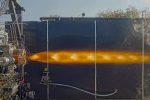NASA-Backed 3D Printed Nozzle Powers Venus Aerospace Hypersonic Engine
Venus Aerospace, a Texas-based hypersonic propulsion company, will incorporate a nozzle developed under a NASA Small Business Innovation Research (SBIR) award into its next ground-based engine demonstration. The component, produced using laser powder bed fusion, is part of Venus’s work on a Rotating Detonation Rocket Engine (RDRE), a compact system designed to operate across multiple flight regimes without engine switching.
The nozzle was developed using advanced NASA alloys—GRCop-42 for high thermal conductivity and GRX-810 for extreme temperature resistance. These materials enabled the construction of complex integrated structures such as coolant channels and injector orifices, which cannot be machined using conventional methods. “The technology we developed with NASA’s support will now be part of our integrated engine platform,” said Venus CEO Sassie Duggleby.
This propulsion architecture relies on continuous spinning detonation waves rather than subsonic combustion. The company has built an engine that eliminates the need for multiple propulsion stages, allowing a vehicle to accelerate from takeoff to speeds exceeding Mach 5 with a single system. “We’ve developed a single system that powers a vehicle from takeoff to hypersonic cruise,” Duggleby added.
The rotating detonation rocket engine (RDRE) undergoing a full-thrust ground test. Photo via Venus Aerospace.
Chief Technology Officer Andrew Duggleby described the RDRE configuration as a “compact, high-performance engine” that is “ready for flight.” While exact performance specifications have not been disclosed, Venus has stated that internal efficiency metrics place the system in the upper 90th percentile compared to conventional rocket engines.
Addressing combustion and cooling challenges
Rotating detonation engines face high thermal loads and complex pressure environments that make traditional manufacturing insufficient for hardware reliability. Additive manufacturing enabled Venus to produce a nozzle capable of withstanding the detonation chamber’s severe conditions, including rapid heat transfer and dynamic pressure cycling. These characteristics are critical for engine durability and integration into full-scale systems.
“We will use it in our Stargazer M4 vehicle and in future vehicles like landers, orbital transfer vehicles, and hypersonic drones,” said Sassie Duggleby. Following successful nozzle trials under SBIR, the upcoming ground test will be the first to assess the hardware in a full propulsion system. With testing scheduled to continue through 2025, Venus is moving toward real-world validation of a propulsion system that merges compact design, jet-like cruise efficiency, and rocket-class performance.
Rendering of Venus Aerospace’s Stargazer vehicle. Image via Venus Aerospace.
Additive manufacturing advances in rocket propulsion
Recent breakthroughs in multi-material 3D printing have enabled new design possibilities for rocket propulsion components. InssTek, a South Korean manufacturer of directed energy deposition (DED) systems, partnered with the Korea Aerospace Research Institute (KARI) to produce a 3-ton multi-material rocket nozzle integrating copper- and nickel-based alloys. This nozzle, featuring internal cooling channels at 1 mm intervals, was tested alongside a C-103 extension and successfully fired in combustion trials.
At Formnext 2024, Eplus3D and engineering firm LEAP 71 unveiled a 1.3-meter single-piece rocket thruster delivering 200 kN of thrust. Manufactured using the EP-M650-1600 metal powder bed fusion system over a 354-hour print cycle, the thruster combines combustion chamber, cooling channels, and structural elements into a unified component. The use of AlSi10Mg alloy and a dual cooling system optimized for cryogenic oxygen and kerosene significantly enhanced heat regulation and reduced pressure loss.
3ton multi-material rocket nozzle with extension. Image via InssTek.
Ready to discover who won the 20243D Printing Industry Awards?
Subscribe to the 3D Printing Industry newsletter to stay updated with the latest news and insights.
Featured image showcase the rotating detonation rocket engine (RDRE) undergoing a full-thrust ground test. Photo via Venus Aerospace.
Anyer Tenorio Lara
Anyer Tenorio Lara is an emerging tech journalist passionate about uncovering the latest advances in technology and innovation. With a sharp eye for detail and a talent for storytelling, Anyer has quickly made a name for himself in the tech community. Anyer's articles aim to make complex subjects accessible and engaging for a broad audience. In addition to his writing, Anyer enjoys participating in industry events and discussions, eager to learn and share knowledge in the dynamic world of technology.


